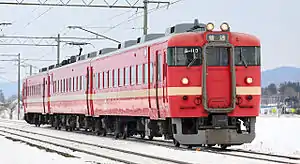| 711 series | |
|---|---|
 711 series set S-113 in service in January 2009 | |
| In service | 1968 – March 2015 |
| Manufacturer | |
| Constructed | 1967–1980 |
| Number built | 114 vehicles (38 sets) |
| Number in service | None |
| Number preserved | 3 vehicles |
| Formation | 3 cars per trainset |
| Operators | JR Hokkaido |
| Depots | Sapporo |
| Lines served | Hakodate Main Line, Chitose Line, Muroran Main Line |
| Specifications | |
| Car body construction | Steel |
| Car length | 20,000 mm (65 ft 7 in) |
| Width | 2,950 mm (9 ft 8 in) |
| Doors | 2 per side |
| Maximum speed | 110 km/h (68 mph) |
| Traction system | Thyristor drive |
| Traction motors | MT54A MT54E |
| Electric system(s) | 20 kV AC (50 Hz) |
| Current collector(s) | Overhead line |
| Bogies | DT38 (motored), TR208 (trailer) |
| Safety system(s) | ATS-SN, ATS-DN |
| Track gauge | 1,067 mm (3 ft 6 in) |
The 711 series (711系, 711-kei) was an AC electric multiple unit (EMU) train type operated by Hokkaido Railway Company (JR Hokkaido) on Sapporo area suburban services in Hokkaido, Japan, from 1968 until March 2015. It was the first AC EMU train to be operated in Japan by the former Japanese National Railways (JNR).[1] The last remaining trains in service were withdrawn on 13 March 2015.[2]
Fleet
By 1 October 2014, 36 vehicles (12 sets) were still in service, all based at Sapporo Depot.[3]
Formations
The 711 series trains were formed as three-car sets with one motored intermediate car and two non-powered driving trailer cars, as shown below.[4]
| Car No. | 1 | 2 | 3 |
|---|---|---|---|
| Designation | Tc' | M | Tc |
| Numbering | KuHa 711-200 | MoHa 711-100 | KuHa 711-100 |
Car 2 was fitted with one N-PS785 single-arm pantograph.[4]
Former prototype sets S901/902
The former prototype sets, S901 and S902 were formed as shown below.[5]
| Designation | Tc | Mc | Tc' |
|---|---|---|---|
| Numbering | KuHa 711-100 | KuMoHa 711-900 | KuHa 711-900 |
Interior
Seating consisted of a mixture of transverse seating bays and longitudinal bench seating.[1]
 Interior of KuHa 711-210 (set S-110) in October 2011
Interior of KuHa 711-210 (set S-110) in October 2011 A four-person seating bay in KuHa 711-210 (set S-110) in October 2011
A four-person seating bay in KuHa 711-210 (set S-110) in October 2011
History
Prototype sets

Two prototype two-car sets, numbered KuMoHa 711-901 + KuHa 711-901 and KuMoHa 711-902 + KuHa 711-902, were delivered in February 1967 for test running ahead of the start of electric suburban services between Otaru and Takikawa from 1968. Both sets were based on the KiHa 22 diesel multiple unit design, but set 901 had opening two-pane windows and featured two sets of four-leaf folding doors per side, whereas set 902 had sealed double-glazed windows, as used on the subsequent full-production sets. The two sets were modified to full-production standards in 1968 and 1970, but set 901 retained its opening windows.[6]
Full-production sets
The first full-production three-car sets were delivered from August 1968.[1] A third, centre, door was added to some of the KuHa 711 cars from 1987.[1] All cars became no-smoking from 1 July 1992.[4] Priority seating was added from 1 October 1997.[4] Air conditioning was added to the two-door sets between 2001 and 2002.[4] The original scissors-type pantographs were replaced with N-PS785 single-arm pantographs between 2004 and 2005.[4]
 Set S107 in original livery in 1982
Set S107 in original livery in 1982 Set S-119 with three-door end cars, November 2009
Set S-119 with three-door end cars, November 2009
Repainted sets

In 2011, set S-110 was repainted into its original JNR all-over crimson livery, and this was followed in May 2012 by a second similarly repainted set, S-114.[7]
Withdrawal

The last remaining sets in service were withdrawn on 13 March 2015.[2]
Preserved examples
As of July 2017, three 711 series vehicles have been preserved, as follows.[8]
- KuHa 711 29: Preserved in Chitose, Hokkaido, and used as the "Cafe Garden Station" restaurant
- KuHa 711 103 + KuHa 711 203: Preserved outside in Iwamizawa, Hokkaido
 Preserved cars KuHa 711 103 + KuHa 711 203 in October 2015
Preserved cars KuHa 711 103 + KuHa 711 203 in October 2015
References
- 1 2 3 4 Jēāru zensharyō handobukku: Rail Magazine 2009 JR全車輌ハンドブック2009 [JR Rolling Stock Handbook 2009]. Japan: Neko Publishing. 2009. p. 8. ISBN 978-4-7770-0836-0.
- 1 2 2015春のJRダイヤ改正 [JR Spring 2015 Timetable Revision]. Japan Railfan Magazine (in Japanese). 55 (650): 19. June 2015.
- ↑ JR電車編成表 2015冬 [JR EMU Formations – Winter 2015] (in Japanese). Japan: Kotsu Shimbunsha. 21 November 2014. ISBN 978-4-330-51614-1.
- 1 2 3 4 5 6 JR電車編成表 2010夏 [JR EMU Formations – Summer 2010]. Japan: Kotsu Shimbunsha. May 2010. p. 2. ISBN 978-4-330-14310-1.
- ↑ JR電車編成表 '98夏号 [JR EMU Formations – Summer 1998]. Japan: JRR. July 1998. p. 5. ISBN 978-4-88283-029-0.
- ↑ プロトタイプの世界 – Prototype World. Japan: Kotsu Shimbunsha. December 2005. p. 111. OCLC 170056962.
- ↑ Katayama (September 2012). 5/28, 711系 S-114編成, 2編成目の国鉄色に [28 May: 711 series set S-114 2nd set to be repainted in JNR livery]. Japan Railfan Magazine. 52 (617): 161.
- ↑ Sasada, Masahiro (25 July 2017). 保存車大全コンプリート: 3000両超保存車を完全網羅 保存車大全 コンプリート [Preserved Rolling Stock Complete Work] (in Japanese). Tokyo, Japan: Ikaros Publications Ltd. p. 224. ISBN 978-4802203845.
Further reading
- 711系物語: 北海道初の「赤電車」誕生から引退まで半世紀のあゆみ 711系物語 [The 711 series story] (in Japanese). Japan: JTB Publishing. 28 March 2015. ISBN 978-4533103483.

